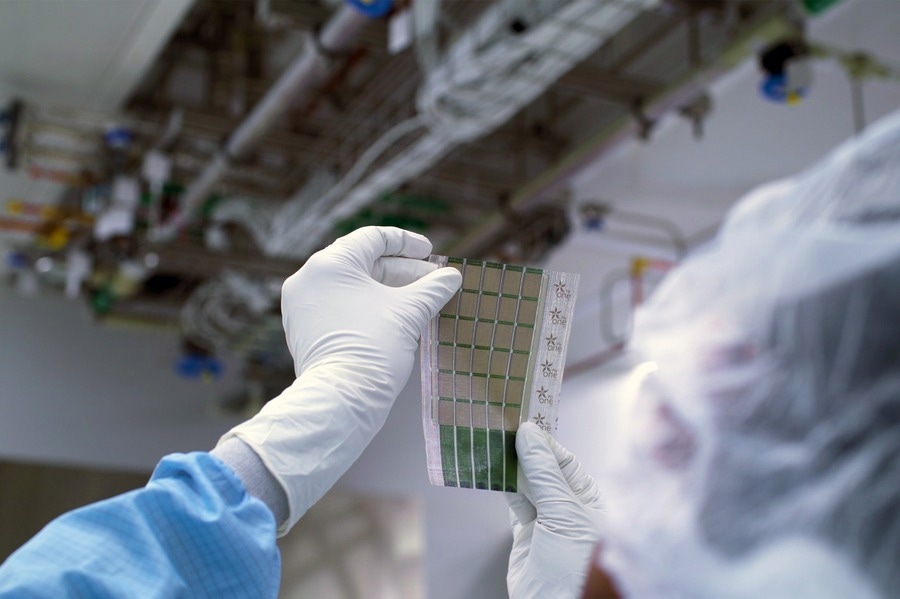Being able to harness the energy of the sun and turn it into a useful electrical power source has long attracted the interest of scientists and researchers, and a team of researchers at MIT has now demonstrated a way to turn almost any surface into a power source having developed solar cells made of an ultralight fabric.

Image Credit: MIT
Published in the journal Small Methods, the team describes the breakthrough as a scalable solution that could transform solar cell technology and create new opportunities when it comes to producing solar energy.
The innovative ultralight cells are able to deliver an energy supply on the go in the form of a wearable power fabric and could be transported and readily deployed in remote locations for use in emergencies, i.e., fixed to tents and tarpaulin in disaster zones for recovery operations.
Durable and Adaptable
Solar technology can be limited to how and where it is used when evaluated against the cost in terms of dollars-per-watt and the bulk they may add to an installation. However, as the ultralight-fabric solar cells can be installed anywhere and onto almost any surface, adaptability becomes relatively simple and more attractive in terms of cost.
The lightweight solar fabrics enable integrability, providing impetus for the current work. We strive to accelerate solar adoption, given the present urgent need to deploy new carbon-free sources of energy.
Vladimir Bulović, the Fariborz Maseeh Chair in Emerging Technology, Leader of the Organic and Nanostructured Electronics Laboratory (ONE Lab), and Director, MIT
The team discovered that the new solar cells were able to generate about 370 watts per kilogram when attached to high-strength Dyneema fabric, which is about 18x more power per kilogram when compared to traditional solar cell technology.
Moreover, when testing durability, the team found that the cells were able to maintain 90% efficiency after being unrolled and rerolled over 500 times.
Printable Electronic Inks
Typically, solar cells are extremely sensitive and fragile, which is why they are enclosed in heavy aluminum and glass frames to protect them when in use. This also means they may be limited to where they can be installed and in what volume.
Yet, through the development of a cutting-edge printing technique using electronic inks, the ONE Lab team was able to print layers of the electronic nanomaterials onto a preprepared, releasable substrate just 3 microns thick. Then, by way of screen printing, the team could place an electrode onto the module to complete the ultralight solar device.
While it might appear simpler to just print the solar cells directly on the fabric, this would limit the selection of possible fabrics or other receiving surfaces to the ones that are chemically and thermally compatible with all the processing steps needed to make the devices. Our approach decouples the solar cell manufacturing from its final integration.
Mayuran Saravanapavanantham, Electrical Engineering and Computer Science Graduate Student, MIT
To overcome potential limitations, such as vulnerability to wear and high risk of tear, the team ensured that they used a lightweight but high-strength substrate for the cells commercially known as Dyneema. This material is so strong that it has been used in applications that require high-tensile strength, such as recovering shipping wreckage from the sea bed.
While these new solar cells are much lighter and demonstrate increased flexibility, they would still need to be encased in another material to ensure they remain protected from the environment. It is possible to enhance and modify the carbon-based organic material used to fabricate the cells to ensure they maintain their performance when exposed to the elements.
References and Further Reading
Saravanapavanantham, M., Mwaura, J. and Bulović, V. (2022) “Printed Organic Photovoltaic Modules on transferable ultra‐thin substrates as additive power sources,” Small Methods, p. 2200940. Available at: https://onlinelibrary.wiley.com/doi/10.1002/smtd.202200940
Zewe, A. (2022) Paper-thin solar cell can turn any surface into a power source, MIT News | Massachusetts Institute of Technology. Available at: https://news.mit.edu/2022/ultrathin-solar-cells-1209
Disclaimer: The views expressed here are those of the author expressed in their private capacity and do not necessarily represent the views of AZoM.com Limited T/A AZoNetwork the owner and operator of this website. This disclaimer forms part of the Terms and conditions of use of this website.